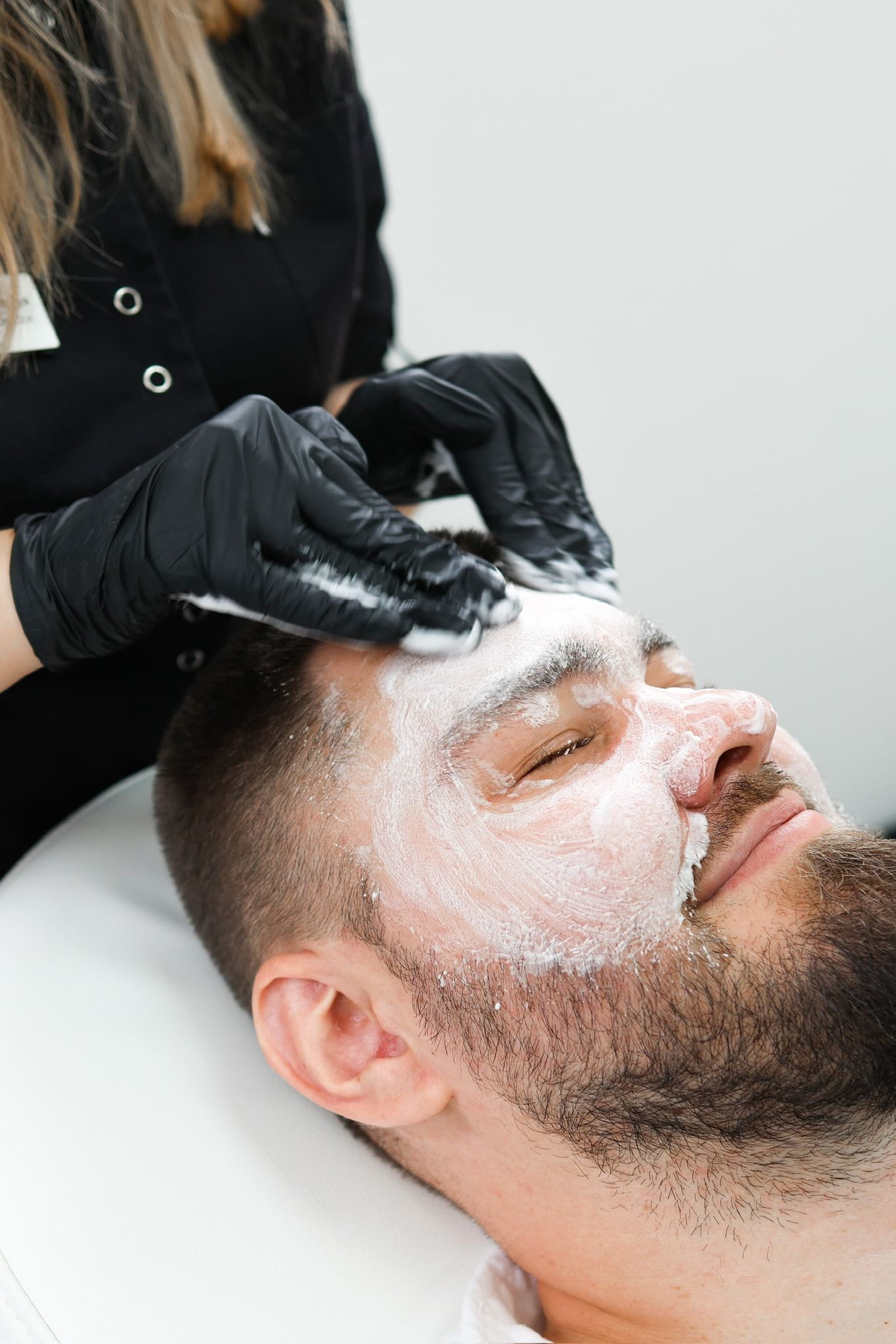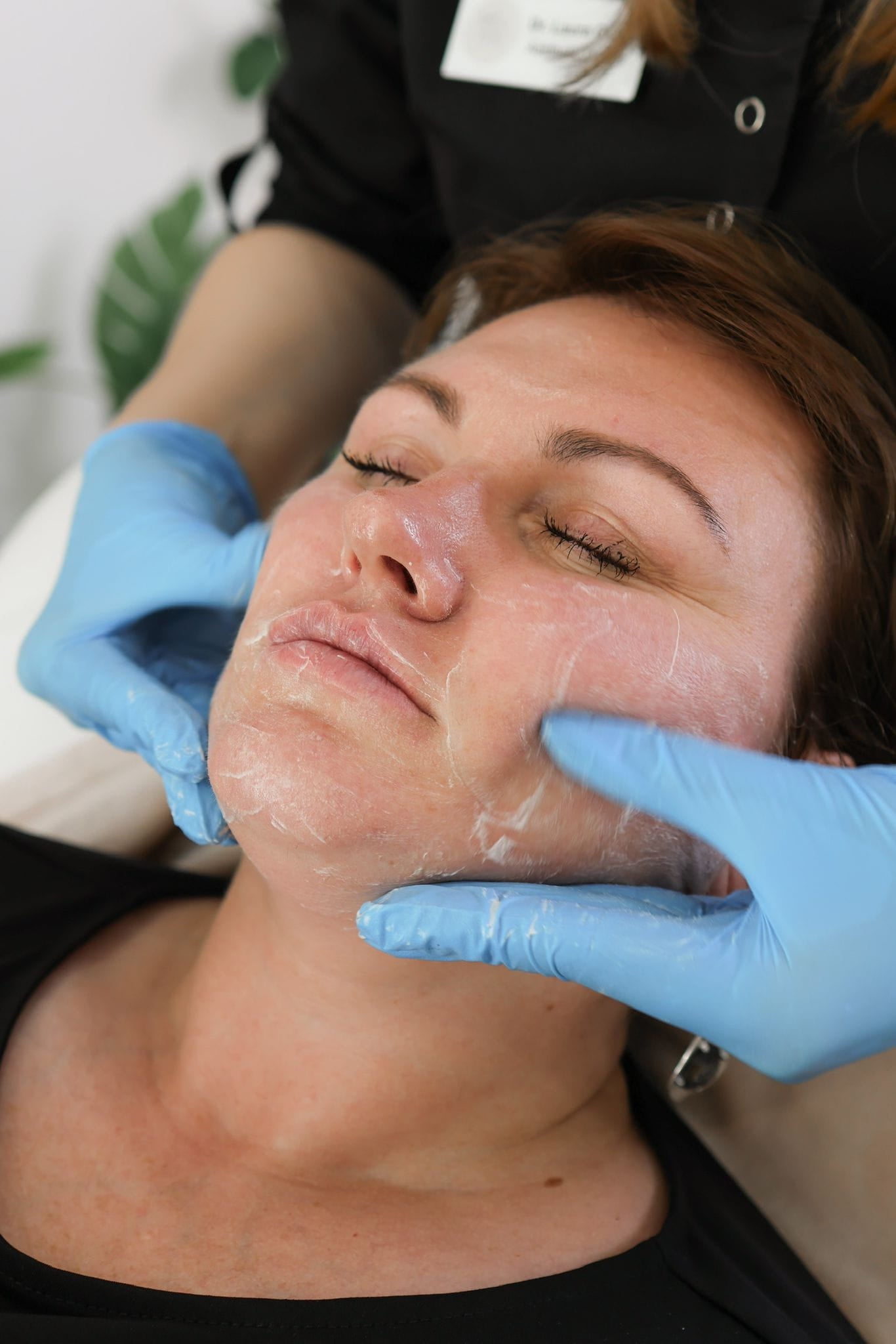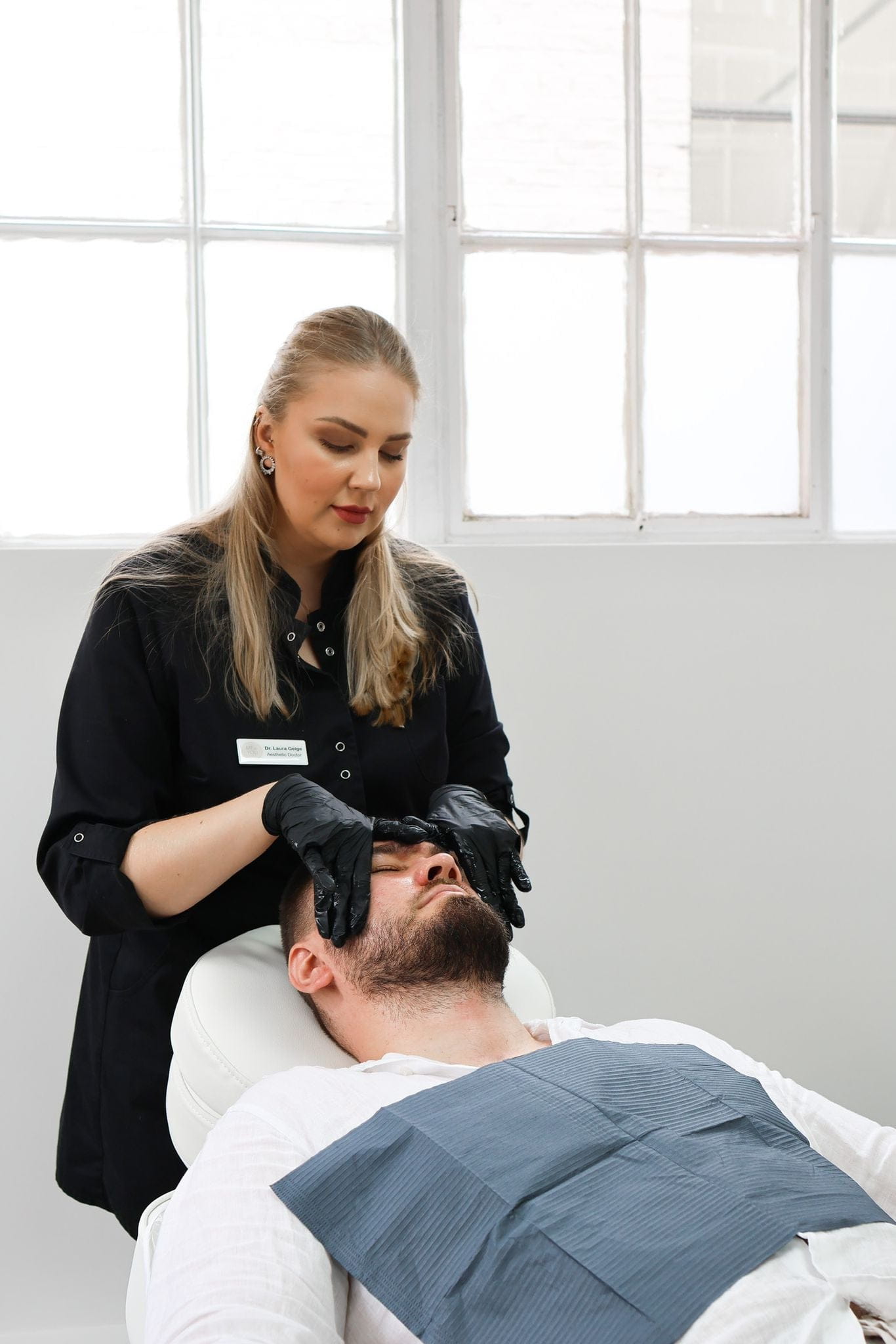Cosmelan Depigmentation Peel
Cosmelan Depigmentation Peel is a specialized treatment designed to address pigmentation concerns like dark spots, hyperpigmentation, and melasma. This intensive peel utilizes powerful ingredients to exfoliate the skin’s surface and target melanin production, resulting in a reduction of discolouration and an overall brighter complexion.
What is Cosmelan?
Cosmelan is a professional-grade depigmentation treatment that effectively addresses pigmentation issues like dark spots, melasma, and hyperpigmentation.
It involves a multi-step process using potent ingredients to exfoliate the skin’s surface and inhibit melanin production, leading to a more even skin tone and reduced discoloration.
How Does It Work?
Cosmelan Depigmentation Peel is a professional treatment designed specifically for pigmentation issues. Unlike some general chemical peels, it targets melanin directly, the pigment responsible for skin color.
This peel uses a combination of powerful ingredients that work together to exfoliate the skin and reduce melanin production. The process involves applying a potent cream to the affected areas followed by specialized aftercare instructions.
Because Cosmelan is designed specifically to target pigmentation, it is often considered more effective than general chemical peels for conditions like melasma and sun spots.
Benefits for Hyperpigmentation
Cosmelan Depigmentation Peel is a professional-grade treatment that effectively addresses pigmentation issues like dark spots, melasma, and hyperpigmentation. Unlike some general chemical peels, it targets melanin directly, the pigment responsible for skin color. This peel uses a combination of powerful ingredients that work together to exfoliate the skin and reduce melanin production.
- How it works: The process involves applying a potent cream containing specific depigmenting agents to the affected areas followed by specialized aftercare instructions.
- Targeted Approach: Because Cosmelan is designed specifically to target pigmentation, it is often considered more effective than general chemical peels for conditions like melasma and sun spots.
The benefits of Cosmelan Depigmentation Peel for hyperpigmentation include:
- Reduction of dark spots, freckles, and sunspots
- Improvement of uneven skin tone
- Diminution of melasma
- Brighter, more even complexion
Potential Side Effects and Risks
While Cosmelan Depigmentation Peel offers numerous benefits for addressing pigmentation concerns, it’s crucial to be aware of potential side effects and risks. Like any chemical peel, Cosmelan can cause temporary side effects such as redness, swelling, itching, dryness, and peeling.
In some cases, these side effects can be more pronounced and may last longer. It’s important to follow the aftercare instructions provided by your dermatologist meticulously to minimize potential complications.
Rarely, but seriously, Cosmelan can lead to post-inflammatory hyperpigmentation (PIH), where skin becomes darker at the treatment site. This can occur if the skin is not adequately protected from sun exposure during the healing process.
Allergic reactions to ingredients in the peel are also possible, though less common. If you experience any unusual or severe side effects after undergoing Cosmelan, seek medical attention immediately.
Cost and Treatment Duration
The cost of a Cosmelan Depigmentation Peel can vary depending on factors like the size of the area being treated, the practitioner’s expertise, and the location of the clinic. In the UK, prices typically range from £300 to £700 for a full face treatment.
The treatment duration generally involves two phases. The initial application of the Cosmelan cream takes approximately 30 minutes.
Following this, you’ll need to wear a mask containing the peel solution for several hours (usually around 6-8 hours) before removing it and applying specialized aftercare products. The full treatment process, including the initial application and the time spent wearing the mask, typically takes a day to complete.
Chemical Peels
Chemical peels are a popular skincare treatment designed to improve the texture and appearance of the skin. They work by using a chemical solution to exfoliate the top layer of skin, revealing smoother, brighter skin beneath. Chemical peels can address various concerns such as acne scars, wrinkles, hyperpigmentation, and sun damage.
Types of Chemical Peels

Chemical peels come in various strengths, categorized by their depth of penetration into the skin:
Superficial peels affect only the outermost layer of skin (the epidermis) and are often used to treat mild imperfections like fine lines, wrinkles, and uneven pigmentation. These peels typically use ingredients such as alpha-hydroxy acids (AHAs) or beta-hydroxy acids (BHAs).
Medium-depth peels penetrate deeper into the dermis, targeting more significant concerns like acne scars, moderate pigmentation issues, and deeper wrinkles. Salicylic acid or trichloroacetic acid (TCA) are commonly used in medium-depth peels.
Deep peels reach the deepest layer of the skin (the subcutaneous tissue) and are reserved for severe skin conditions such as deep acne scarring or significant sun damage. Phenol is a strong chemical often used in deep peels.
How They Work
Chemical peels work by using a solution to exfoliate the top layers of your skin. This removes dead skin cells and promotes cell turnover, leading to smoother, brighter skin.
There are different types of chemical peels categorized by their depth of penetration:
Superficial peels affect only the epidermis (the outer layer of skin) and are suitable for mild concerns like fine lines, wrinkles, and uneven pigmentation.
Medium-depth peels penetrate deeper into the dermis (the second layer of skin) and can address more significant issues such as acne scars, deeper wrinkles, and moderate pigmentation problems.
Deep peels reach the deepest layers of the skin and are typically reserved for severe skin concerns like deep acne scarring or extensive sun damage.
Benefits for Skin Concerns
Chemical peels offer a range of benefits for various skin concerns. They work by exfoliating the top layer of skin, revealing smoother, brighter skin beneath. Different types of chemical peels target specific issues.
Superficial peels are suitable for mild imperfections like fine lines, wrinkles, and uneven pigmentation. Medium-depth peels address more significant concerns such as acne scars, deeper wrinkles, and moderate pigmentation problems. Deep peels are reserved for severe skin conditions like deep acne scarring or extensive sun damage.

Chemical peels can improve the texture and appearance of the skin by reducing wrinkles, minimizing pores, and fading hyperpigmentation. They can also help to treat acne scars, sun damage, and other skin imperfections.
Side Effects and Risks
Chemical peels are a popular skincare treatment designed to improve the texture and appearance of the skin. They work by using a chemical solution to exfoliate the top layer of skin, revealing smoother, brighter skin beneath. Chemical peels can address various concerns such as acne scars, wrinkles, hyperpigmentation, and sun damage.
Chemical peels come in various strengths, categorized by their depth of penetration into the skin:
- Superficial peels: These affect only the outermost layer of skin (the epidermis) and are often used to treat mild imperfections like fine lines, wrinkles, and uneven pigmentation. These peels typically use ingredients such as alpha-hydroxy acids (AHAs) or beta-hydroxy acids (BHAs).
- Medium-depth peels: These penetrate deeper into the dermis, targeting more significant concerns like acne scars, moderate pigmentation issues, and deeper wrinkles. Salicylic acid or trichloroacetic acid (TCA) are commonly used in medium-depth peels.
- Deep peels: These reach the deepest layer of the skin (the subcutaneous tissue) and are reserved for severe skin conditions such as deep acne scarring or significant sun damage. Phenol is a strong chemical often used in deep peels.
Chemical peels work by using a solution to exfoliate the top layers of your skin. This removes dead skin cells and promotes cell turnover, leading to smoother, brighter skin.
There are different types of chemical peels categorized by their depth of penetration:
- Superficial peels: These affect only the epidermis (the outer layer of skin) and are suitable for mild concerns like fine lines, wrinkles, and uneven pigmentation.
- Medium-depth peels: These penetrate deeper into the dermis (the second layer of skin) and can address more significant issues such as acne scars, deeper wrinkles, and moderate pigmentation problems.
- Deep peels: These reach the deepest layers of the skin and are typically reserved for severe skin concerns like deep acne scarring or extensive sun damage.
Chemical peels offer a range of benefits for various skin concerns. They work by exfoliating the top layer of skin, revealing smoother, brighter skin beneath. Different types of chemical peels target specific issues.
Superficial peels are suitable for mild imperfections like fine lines, wrinkles, and uneven pigmentation. Medium-depth peels address more significant concerns such as acne scars, deeper wrinkles, and moderate pigmentation problems. Deep peels are reserved for severe skin conditions like deep acne scarring or extensive sun damage.
Chemical peels can improve the texture and appearance of the skin by reducing wrinkles, minimizing pores, and fading hyperpigmentation. They can also help to treat acne scars, sun damage, and other skin imperfections.
Cost and Treatment Duration
Chemical peels are a popular skincare treatment designed to improve the texture and appearance of the skin. They work by using a chemical solution to exfoliate the top layer of skin, revealing smoother, brighter skin beneath.
Chemical peels vary in cost depending on factors like the size of the area treated, the type of peel used, and the practitioner’s experience. A superficial chemical peel might range from £50 to £200, while a medium-depth peel could cost £150 to £400.
The duration of a chemical peel treatment depends on the type of peel. Superficial peels often only take about 30 minutes, whereas medium-depth peels may take longer and require several applications spread over weeks or months.
Comparing Cosmelan and Chemical Peels
Cosmelan Depigmentation Peel and Chemical Peels are both popular skincare treatments aimed at improving skin appearance. Cosmelan is a specialized peel designed specifically to target pigmentation issues like dark spots, melasma, and hyperpigmentation. Chemical peels, on the other hand, encompass a range of procedures with varying strengths that address various skin concerns such as acne scars, wrinkles, and uneven skin tone.
Effectiveness for Hyperpigmentation
Cosmelan Depigmentation Peel and chemical peels are both popular skincare treatments designed to improve skin appearance, but they target different concerns and work in distinct ways.
Cosmelan is a specialized peel formulated to address pigmentation issues like dark spots, melasma, and hyperpigmentation. It utilizes potent ingredients that exfoliate the skin’s surface and inhibit melanin production, leading to a reduction in pigmentation and a brighter complexion. Chemical peels, however, encompass a broader range of procedures with varying strengths. They use chemical solutions to exfoliate the top layer of skin, revealing smoother and brighter skin beneath.
While both treatments can be effective for improving skin tone and texture, Cosmelan is generally considered more specialized and potent in addressing pigmentation concerns due to its targeted approach. Chemical peels offer a wider range of options for treating various skin issues, from mild imperfections like fine lines and wrinkles to more significant concerns such as acne scars and sun damage.
Downtime and Recovery
Cosmelan Depigmentation Peel and chemical peels both aim to improve the appearance of your skin but work in different ways. Cosmelan is specifically designed to tackle pigmentation problems like dark spots, melasma, and hyperpigmentation by inhibiting melanin production. It uses a potent cream with specialized ingredients that exfoliate the skin’s surface.
Chemical peels, on the other hand, use various chemical solutions to exfoliate the top layer of skin. There are different types of chemical peels categorized by their depth: superficial (for mild concerns like fine lines), medium-depth (for moderate concerns like acne scars), and deep (for severe concerns like deep acne scarring).
When it comes to downtime, Cosmelan generally requires more recovery time than many chemical peel types. After the initial application of Cosmelan, you’ll need to wear a mask for several hours followed by specific aftercare instructions. You can expect redness, peeling, and sensitivity for up to a week or two.
Superficial chemical peels often have minimal downtime, with some mild redness subsiding within a day or two. Medium-depth peels might require a few days of recovery, while deep peels necessitate several weeks of healing and downtime.

Long-Term Results
Cosmelan Depigmentation Peel and chemical peels are both popular treatments for improving skin appearance, but they have distinct differences that make them suitable for different needs.
Cosmelan is specifically designed to target pigmentation issues like dark spots, melasma, and sunspots. It uses a potent cream with ingredients that exfoliate the skin’s surface and inhibit melanin production, leading to a reduction in pigmentation. Cosmelan requires more recovery time than many chemical peels, with redness, peeling, and sensitivity lasting for about two weeks.
Chemical peels encompass a wider range of procedures using various chemical solutions to exfoliate the top layer of skin. They are categorized by their depth: superficial, medium-depth, and deep. Superficial peels address mild concerns like fine lines and uneven skin tone, while deeper peels target more significant issues like acne scars and wrinkles. Downtime varies depending on the type of peel used, with superficial peels having minimal downtime compared to more invasive procedures.
If your primary concern is pigmentation, Cosmelan might be a better choice due to its specialized formula and proven effectiveness in addressing melanin production. However, if you have other skin concerns like acne scars or wrinkles, a chemical peel may be a more suitable option, allowing you to customize the treatment to address your specific needs.
Ultimately, the best choice for you depends on your individual skin type, concerns, and desired outcome. Consulting with a dermatologist or qualified skincare professional is crucial to determine the most appropriate treatment plan for your specific needs.
Suitability for Different Skin Types
Cosmelan Depigmentation Peel and chemical peels are both popular skincare treatments aimed at improving skin appearance, but they target different concerns and work in distinct ways.
Cosmelan is a specialized peel formulated to address pigmentation issues like dark spots, melasma, and hyperpigmentation. It utilizes potent ingredients that exfoliate the skin’s surface and inhibit melanin production, leading to a reduction in pigmentation and a brighter complexion. Chemical peels, however, encompass a broader range of procedures with varying strengths. They use chemical solutions to exfoliate the top layer of skin, revealing smoother and brighter skin beneath.
When choosing between Cosmelan and a chemical peel, consider your specific skin concerns. Cosmelan is ideal for those struggling with pigmentation issues, while chemical peels offer more versatility for addressing a wider range of concerns such as acne scars, wrinkles, and uneven skin tone.
The best approach is to consult with a dermatologist or qualified skincare professional. They can assess your skin type, concerns, and desired outcome to recommend the most suitable treatment option for you.
Choosing the Right Option for You in the UK
Choosing the right skincare treatment can be overwhelming with so many options available. When considering pigmentation issues in the UK, two popular choices stand out: Cosmelan Depigmentation Peel and Chemical Peels. Both offer benefits for improving skin tone and texture, but their approaches and suitability differ.
Consultation with a Dermatologist or Aesthetics Practitioner
Choosing between Cosmelan Depigmentation Peel and chemical peels depends on your individual needs and skin concerns.
Cosmelan is a specialized peel designed to effectively target pigmentation issues like dark spots, melasma, and hyperpigmentation. It works by inhibiting melanin production, resulting in a more even skin tone.
Chemical peels offer a wider range of options for addressing various skin concerns, including acne scars, wrinkles, and uneven texture. The type of chemical peel used will depend on the depth needed to address your specific concern.
Before making a decision, it’s essential to consult with a dermatologist or aesthetics practitioner in the UK. They can assess your skin condition, understand your goals, and recommend the most suitable treatment option for you. They will also be able to advise on potential side effects and aftercare instructions.
Factors to Consider: Skin Type, Concerns, Budget, Lifestyle
Choosing the right option for you in the UK involves carefully considering several factors:
- Skin Type: Different skin types react differently to treatments. If you have sensitive skin, a superficial chemical peel might be a better starting point than a more potent treatment like Cosmelan.
- Concerns: Cosmelan is specifically designed for pigmentation issues, while chemical peels offer broader solutions for various concerns like acne scars, wrinkles, and uneven texture.
- Budget: Cosmelan Depigmentation Peel tends to be more expensive than superficial chemical peels.
- Lifestyle: Cosmelan requires a longer recovery period with potential redness and peeling for several weeks, while some chemical peels have minimal downtime. Consider your schedule and ability to take time off for healing.
- The Benefits Of CBD Gummies For Managing Chronic Conditions - December 6, 2025
- THC Infused Teas You Need In Your Life - December 4, 2025
- Temple Filler Near New Malden And Coombe, Surrey - December 2, 2025
